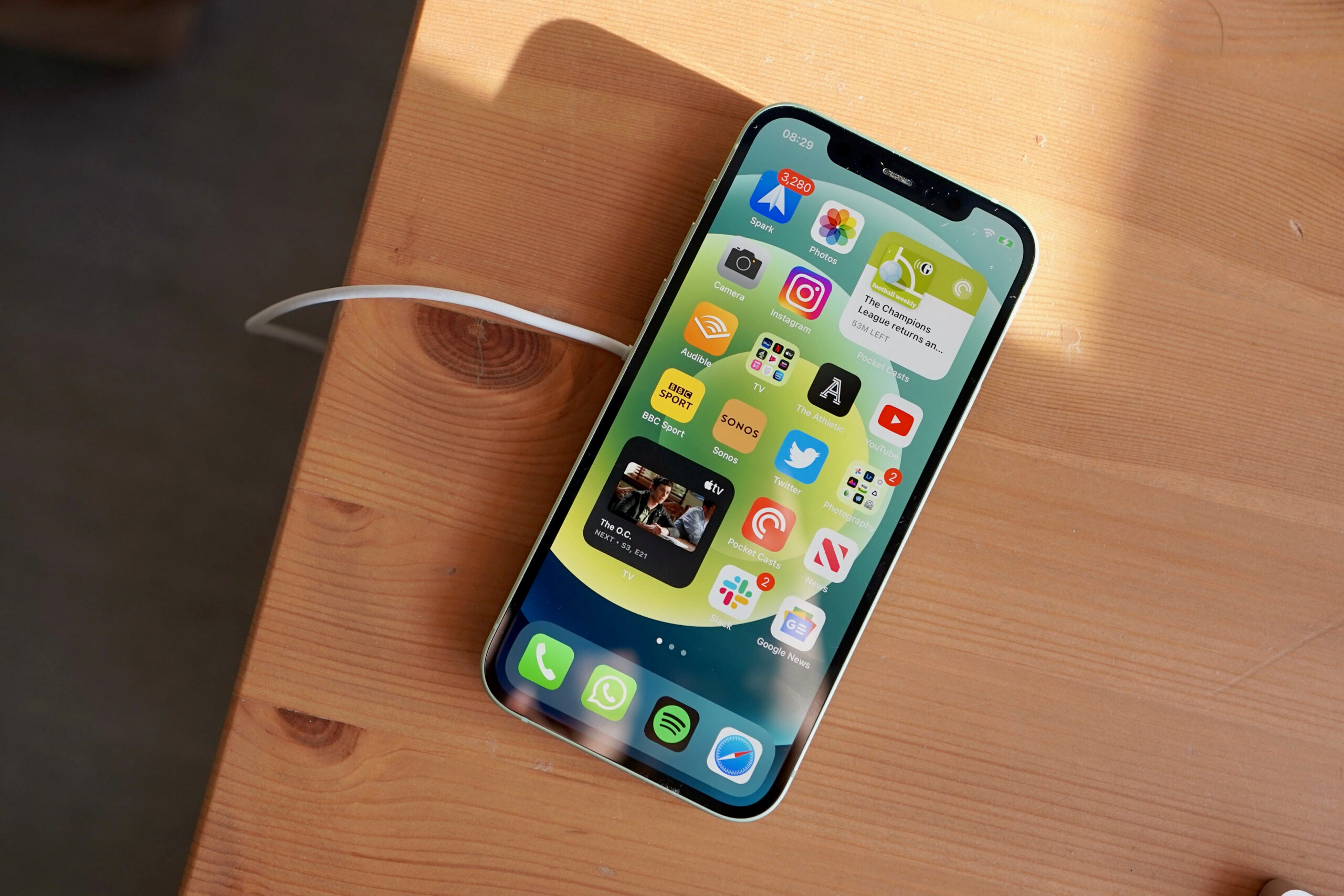Verdict
It may not be the most recent iPhone, but the iPhone 12 can still offer plenty of bang for its buck. At a reduced £649/$599, it remains a tempting device.
Pros
- Fantastic design
- Very reliable cameras
- Strong performance
Cons
- Screen lacks some of the benefits you’ll find elsewhere
- The notch remains annoying
Availability
- UKRRP: £649
- USARRP: $599
- EuropeRRP: €809
- CanadaRRP: CA$849
- AustraliaRRP: AU$1049
-
DesignRefreshed design that separates the iPhone from the Android competition -
PerformanceSolid, nippy performance when browsing and gaming -
Reliable camera performanceGreat point-and-shoot capabilities and HDR video support
With the iPhone 12, Apple brought many of its ‘Pro’ level features from the iPhone 11 Pro down to the entry-level range.
The iPhone 12 is a complete redesign of the iconic smartphone when compared to the iPhone 11, bringing it back to something akin to that of the angular iPhone 5.
Big updates include screen improvements, 5G support and better camera performance compared to its predecessor, and although it saw a slight price increase at launch, it’s now much more affordable in the UK at £649 and even cheaper in the US at $599.
If you’re curious about other models in the iPhone 12 family, our iPhone 12 Pro review looks at the differences between it and the cheaper model, while the iPhone 12 mini review focuses on the smaller model. We’ve also got an iPhone 12 Pro Max review – is the camera really so much better than the standard iPhone 12?
We’ve also got the best iPhone if you’re curious about how the iPhone 12 compares to more recent models of iPhone.
Design
- Biggest iPhone redesign in a few years
- Almost identical to iPhone 12 Pro in design
- Ceramic Shield display protection
The iPhone 12 is a gorgeous phone and the best-looking Apple phone since the iPhone 5 – a device this takes a lot of inspiration from. The rounded sides and slightly curved display have been replaced with flat edges and straight lines everywhere. It’s clean, supremely well-built and an absolute pleasure to use.
It’s thinner, lighter, smaller and more ergonomic than the iPhone 11 it replaced and the flat sides make it far more comfortable to hold. Everything just works, from the size to the weight. It’s a tougher phone too, with more durable glass on the front and a better IP68 rating for splash, water and dust resistance. Apple now claims it’ll withstand a maximum depth of 6m for 30 minutes.
It’s a design that Apple has kept for the iPhone 13, iPhone 14 and likely the iPhone 15 if rumours are to be believed, so it’ll feel just as fresh as a newer iPhone in the hand.
Interestingly, the iPhone 12 is the exact same as the iPhone 12 Pro when it comes to dimensions and screen size. If you buy a case for one, it’ll work with the other. There are differences though: the iPhone 12 swaps stainless steel rails for cheaper aluminium and it’s noticeably lighter as a result. The Pro model also has a frosted glass back, while the 12 has a more glossy finish. It’s the opposite on the sides though, as the 12 goes matte here and the Pro goes (very) shiny.
In the lovely green colour my review unit came in, the back isn’t that susceptible to visible fingerprints, however this won’t be the case if you choose a darker model – the blue, black or red version, for example.
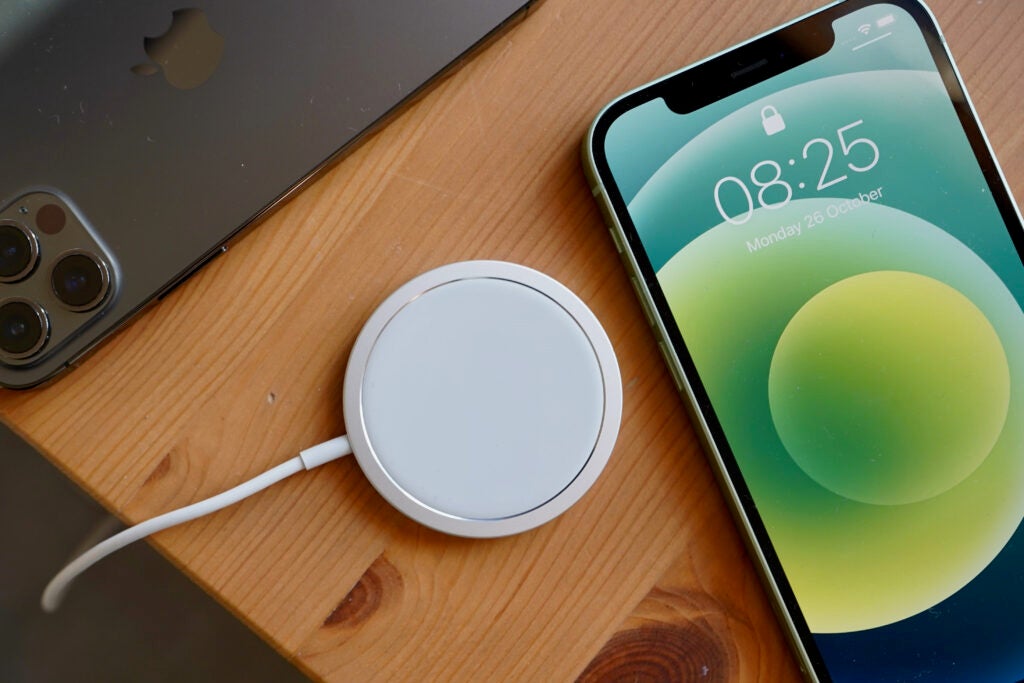
Image Credit (Trusted Reviews)
Whichever colour you choose, the hue wraps around the side and while the choice isn’t quite as varied as with the iPhone 11, each tone is tasteful.
Covering the front of the iPhone 12 is Apple’s ‘Ceramic Shield’. This is developed in conjunction with Corning, from Gorilla Glass fame, and is, according to Apple, 4x better at withstanding drops. Apple has added nano-ceramic crystals into the glass which are said to make it much stronger and this is combined with the previously used dual ion-exchange for scratch resistance.
Now, and this is important, the iPhone 12 isn’t any more scratch resistant than the iPhone 11, nor is it any worse than the Ceramic Shield used on newer iPhones – the tech has remained unchanged since the iPhone 12’s launch. Often when things become better at withstanding drops, they become more susceptible to other types of damage, like scratches. I haven’t noticed any scratches on mine, but this isn’t an excuse to ditch the screen protector if you would have used one before.
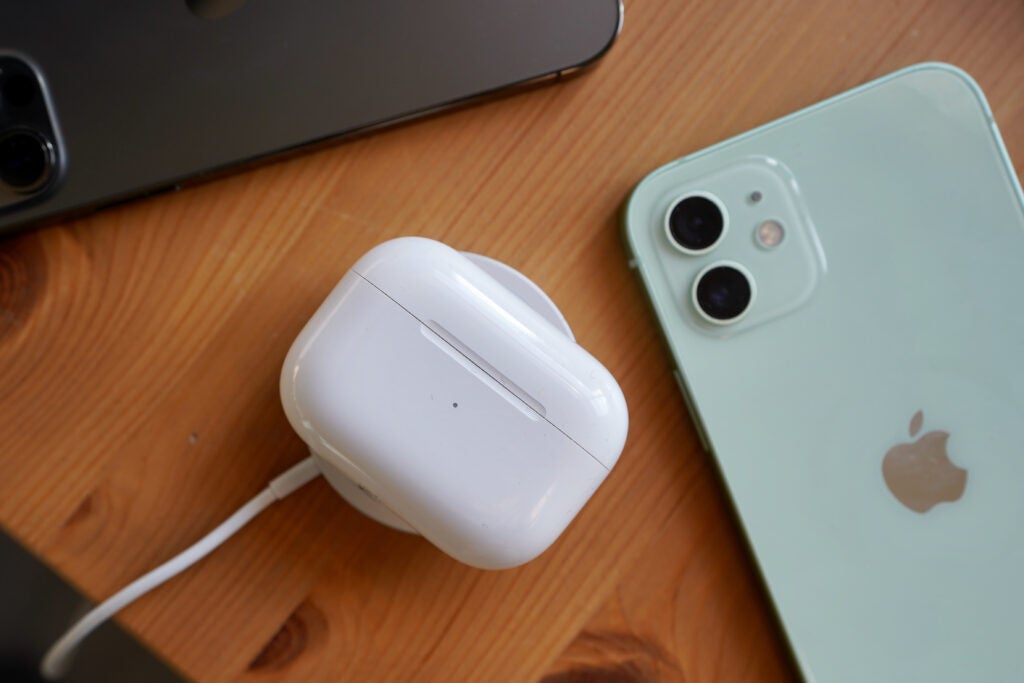
Image Credit (Trusted Reviews)
Screen
- 6.1-inch OLED display
- HDR support
- Capped at 60Hz
Apple skimped on the display of the iPhone 11. It wasn’t OLED like the Pro models, but LCD and it had a resolution that was only slightly above 720p. There was no HDR support either, leaving compatible media looking somewhat flat. With the iPhone 12, that’s all changed.
The upgraded display is up there with the biggest upgrades of the iPhone 12 and if you’re coming from an iPhone 11, iPhone XR or below you’ll notice it immediately. Apple might have some fantastic LCD displays, but the switch to OLED is welcome and the panel here is virtually indistinguishable from the one in the 12 Pro. Everything is more vivid, has better contrast and is generally more pleasing to the eye.
Using OLED also allows for the smaller bezel around the display and it enables HDR in formats like Dolby Vision and HLG. It’s sharper too, now over 1080p, and just generally much better.
One minor thing to note is that the 12 Pro model gets ever-so-slightly brighter in regular use, giving whites less of a grey tinge. You’ll really only notice this if you have the two side-by-side and they can both hit 1200 nits (according to Apple) when you’re playing back HDR content. Streaming Avengers: Endgame from Disney Plus in Dolby Vision is a great test for this screen and you notice that extra brightness in dark scenes heavy with gunfire and bright explosions.
At 6.1-inches, the screen here is a good, middle-ground size. Small enough to grip in one hand, but big enough to happily watch media and play games on without it feeling cramped. If you want bigger you’ll have to stump up for the Pro Max, while those after something more akin to older iPhones like the iPhone 5 should look at the iPhone 12 Mini. Apple’s done a fantastic job at catering for all sizes and I wish more Android manufacturers would follow its example.
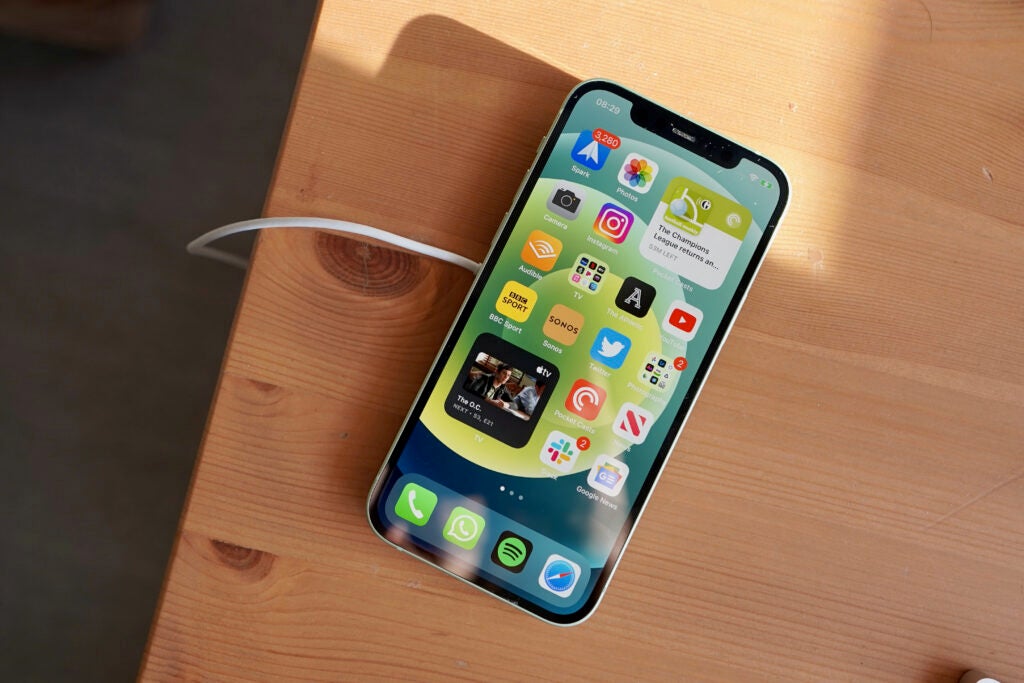
Image Credit (Trusted Reviews)
There are a couple of areas where Apple can still improve the display experience, though. My main request is for a faster overall screen, upping that 60Hz to something closer to 90Hz or 120Hz. Apple’s ProMotion 120Hz display technology does make an appearance on newer iPhones, though it’s exclusive to the pricier Pro and Pro Max models.
I would also like Apple to reduce (or get rid of) the notch. While Apple has made significant improvements to the notch in more recent iPhones, especially the redesigned Dynamic Island of the iPhone 14 Pro & Pro Max, it’s still prominent on the entry-level models. You’ll get used to it yes, and after a while I forgot it was there – but more screen real estate would be nice.
Performance
- 5G is handy but not a must-have
- A14 Bionic is still capable in 2023
- Nippy day-to-day performance
5G is the big performance gain for the iPhone 12 and every model in the series has it. If you’re in the States you’ll have mmWave UWB 5G support on networks like Verizon, while us UK folks are restricted to the more widespread sub–6Ghz bands. Annoyingly, we’re still paying the same price, even though the UK model lacks the mmWave antennas.
It’s worth saying right away that even though networks and Apple want you to think 5G is a reason to upgrade or buy this iPhone, I don’t think it is. Even years after launch, good 5G connectivity is still only available in small portions of even supported areas, seems pretty hit-or-miss in terms of speed when compared to 4G still and does hammer battery life if you’re pushing it with downloads. Apple seems to agree, at least in part, as a Smart 5G feature will bring you back to 4G if it thinks what you’re doing doesn’t really warrant those extra speeds.
Related: What is 5G?
Using 5G could make a difference when attending gigs, large sporting events and festivals where connectivity really matters. For most users though, it’s a nice to have rather than a must.
Powering the iPhone 12 is the A14 Bionic chipset. This is the same chip you’ll find powering the fourth-generation iPad Air. While it trails behind Apple’s more recent A16 Bionic, it remains a triumph of engineering, built on the supremely efficient 5nm process and is the likely reason why battery life is roughly the same as the iPhone 11 even with the additions of 5G and a better display. It’s a brute in terms of performance too, with benchmarks not too far from that of more recent Android flagships. I ran the synthetic CPU benchmark and got a multi-core score of 3927, with a single-core 1590 result.
A lot of the power from this chip is used in parts of the phone you won’t immediately notice. Whether it’s enabling Dolby Vision recording or the AI elements in the camera, that beefier chip isn’t just there to make your homescreen flow faster or games load quicker.
In general day-to-day performance, the iPhone 12 is very quick and while it’s just as nippy as the Pro, I don’t think you’ll notice much difference unless you’re upgrading from a really old iPhone. iPhones have, to me, always felt and stayed fast and this is no different.
The only real difference in terms of specs between the iPhone 12 and iPhone 12 Pro is that the latter has a bit more RAM: 6GB, as opposed to 4GB. You likely won’t notice this benefit yet though, and I certainly couldn’t. You also get 128GB storage as standard on the Pro, as opposed to 64GB here.
Audio from the speakers is great (loud, detailed and without distortion even at full volume), call quality is strong and there’s Wi-Fi 6 support if you have the right router.
While the iPhone 14 shipped with iOS 14, it has since had the upgrade to iOS 15 and most recently, iOS 16, bringing with it key new software features. Apple’s long-term software support is one of the big reasons to get an iPhone compared to the Android competition, even with increased support from many Android manufacturers in recent years.
Camera
- Dual rear-camera setup
- HDR video support
- Great all-round performance
The iPhone 12 has seen many big upgrades over its predecessor and that makes the changes to the camera feel a bit less substantial. There is new stuff and some obvious improvements, especially when you’re shooting low-light, but generally the photos I have taken look very much like those from the iPhone 11 series.
Related: Best camera phones
That’s far from a bad thing, though. The main 12-megapixel sensor now has a faster f/1.6 7-element lens and it’s paired with a 12MP ultrawide camera too. If you want telephoto (and the perks of the LiDAR sensor) there’s the iPhone 12 Pro.
The real strength of the iPhone 12’s camera is in its reliability. The Smart HDR 3 and Deep Fusion tech inside the camera app does a stunning job at levelling out colours and dynamic range. It does an almost unmatched job of ensuring exposure is correct in every photo. If you’re taking tricky shots with multiple levels of brightness then the iPhone 12 can handle it with ease and this is not something I can say about every phone from Huawei, Samsung and others.
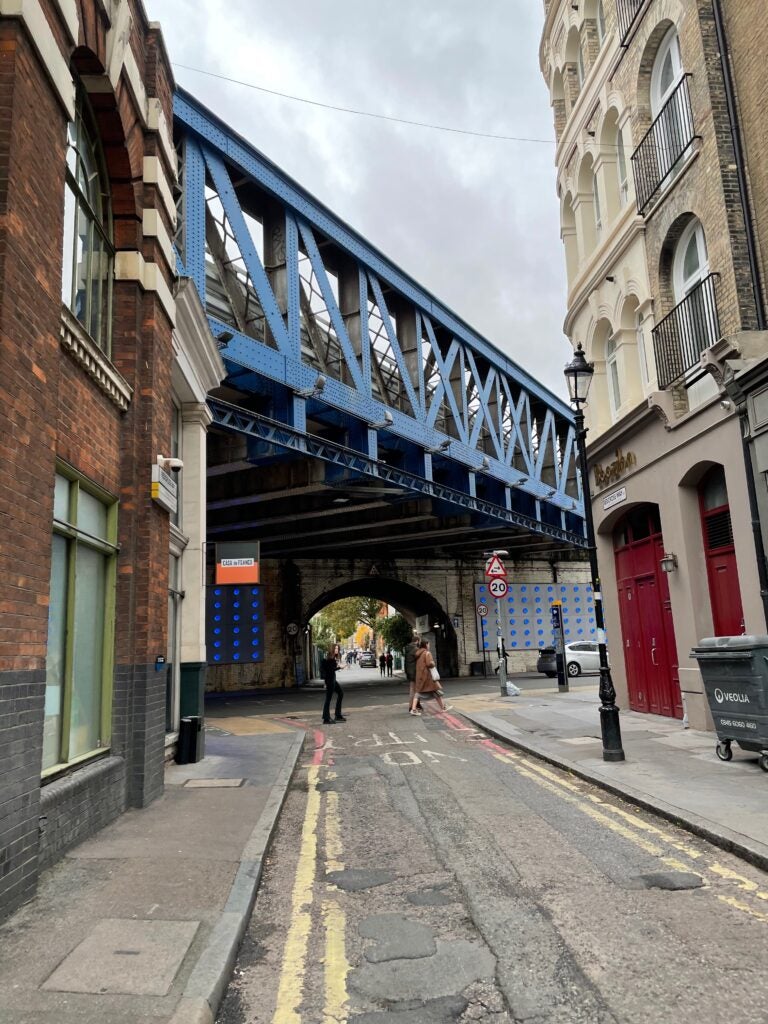
Image Credit (Trusted Reviews) : Exposure is kept in control with fantastic skill

Image Credit (Trusted Reviews) : Huge amounts of details is pulled from the sensor

Image Credit (Trusted Reviews)
The f/1.6 aperture helps in darker scenarios, as it lets more light (27% according to Apple) into the sensor. I have found snaps in situations where the dedicated Night Mode doesn’t activate are a little bit sharper with far better colour and highlight reproduction than the 11 Pro, and a lot better overall than those on an iPhone XS. As I would guess most people are upgrading from an older iPhone that’s really the most important metric.
Another notable change with the iPhone 12 is that Night Mode and Deep Fusion work across both sensors. This improves night shots in the ultrawide, however the shots are still inferior just down to the sensor not being quite as capable. Night Mode on the main camera is still great and if you’re coming from an iPhone pre-11 then you’ll be blown away by what you can achieve with little to no light. Even the upgrade over the iPhone 11 Pro is noticeable here very obviously here, with colours coming across far brighter.
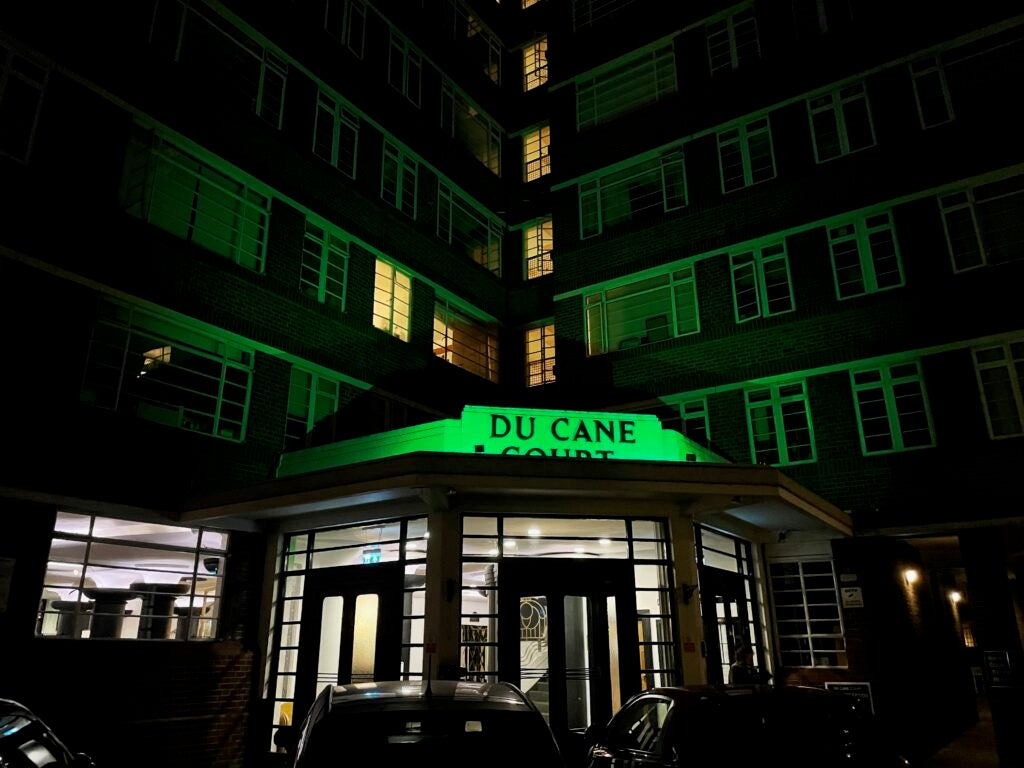
Image Credit (Trusted Reviews): Even with Night Mode off, low light shots are great. Colours, especially, are bright
The front camera is very much the same as its predecessor. It’s a 12MP sensor, with an f/2.2 aperture and it’s used mainly for the Face ID unlocking system. Selfies are fine, but they can look a little washed out when compared to the overtly contrasty look you’ll get from a recent Pixel smartphone.
Video has always been a highlight of the iPhone, and that continues with the iPhone 12.
The big new addition is HDR recording. HDR gives you better contrast, brighter colours and an overall pleasing look. Here, HDR video is recorded in an HLG format with some Dolby Vision encoding on top. That’s beside the point though, as the results are stunning and especially when viewed on the iPhone 12’s HDR screen. Colours pop, skies stand out even and there’s a real energy that now feels missing when I go back to the iPhone 11. You can easily share these videos with other iPhone users, and while third-party support was initially spotty, they now play nicely in most third-party apps.
Battery life
- No charger in the box
- Average battery life
- MagSafe and Qi wireless charging
There were notable gains across the board in terms of battery life with the iPhone 11, however things are more modest with the iPhone 12. The 2815mAh (same in both the 12 and 12 Pro) battery has been getting me roughly the same about of juice as the 11, which is impressive considering all the extra benefits you’re getting.
The lack of a huge jump in endurance might irk some though and this remains a phone you’ll most likely be charging every day – a contrast to more recent models of iPhone like the iPhone 14 Plus.
Per charge, I have been getting around 6 hours of screen on time and this is very much the same as the 12 Pro. An hour of HDR streaming from Netflix ate through 8%.
Now, there are some caveats here. I spend a lot of time at home and I’m often using Wi-Fi more often than mobile connectivity. I also don’t live in a reliable 5G area (sometimes it pops up, but speeds are rarely faster than 4G) so if you’re pounding downloads on a 5G network expect to hit 0% far quicker.
Probably the biggest controversy with the iPhone 12 is the lack of a plug in the box. There’s just a USB C cable and, well, nothing else. EarPods and a wall brick have been ditched, which make for a far slimmer box and hopefully a benefit to the environment in the long run. It’s a trend that many Android manufacturers have picked up on since, including the likes of Samsung with its flagship Galaxy range.
While it’s great the included cable is USB C, very few people (I would suggest) would have plentiful USB bricks lying around their house. This would be nulled somewhat if Apple has switched the phone over to USB C so could use the same plug and cable combi you charge an iPad or laptop with, but it didn’t. Lightning remains and I just can’t see why.
Also, if you’re encouraging people to reuse a charger from an older iPhone then they’re going to be suffering from seriously slow charging speeds. A 5w brick (the one you’d have with all iPhones aside from the older Pro models) will take over hours and hours to charge this. While a 20w brick takes you to 50% in just over 30 minutes.
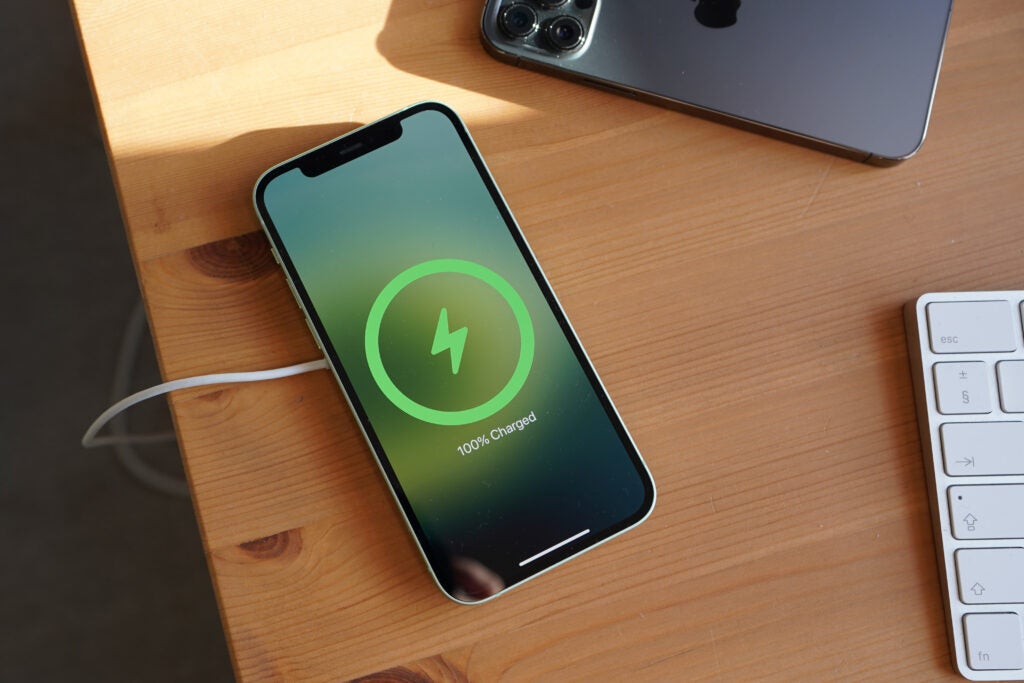
Image Credit (Trusted Reviews)
Realistically you’re going to want to buy a 20w plug to use with this phone and that’s another expense.
You’ll also need one of those 20w plugs if you want to use the new MagSafe charger – a £40/$40 magnetic wireless charger that’s part of a whole range of add-ons. It uses magnets, NFC and the Qi standard to charge your iPhone 12 at 15w, giving you about 50% in an hour. I’ve gone into depth on MagSafe here. iPhone 12 still works with other Qi chargers, with speeds topping out at 7.5w.
Final Thoughts
While it has since been replaced by the iPhone 13 and more recently the iPhone 14, the iPhone 12 represents a notable jump for Apple’s mainline phone – and it’s still a decent performer in 2023. It’s also £150 cheaper now than it was at launch, at a more tempting £649.
Related: Best phone
The screen still holds up in 2023 (even if a higher refresh rate screen would be nice), the design is still the best you’ll find and the cameras reliably take ace snaps in all manner of conditions. There’s also 5G, HDR video recording, all the benefits of iOS and MagSafe.
Specifications
UK RRP
USA RRP
EU RRP
CA RRP
AUD RRP
Manufacturer
Screen Size
Storage Capacity
Rear Camera
Front Camera
Video Recording
IP rating
Battery
Wirless charging
Fast Charging
Size (Dimensions)
Weight
ASIN
Operating System
Release Date
First Reviewed Date
Model Number
Resolution
HDR
Refresh Rate
Ports
Chipset
RAM
Colours
Bin capacity


















